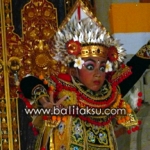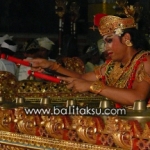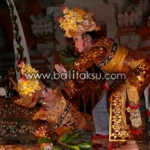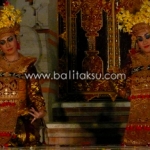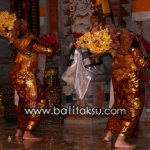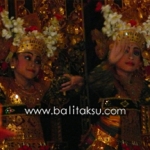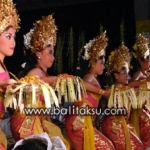Odalan
Om Suastiastu,
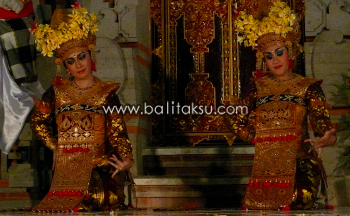
Saturday, April 17th 2010, was the Odalan at the temple of Banjar Kalah Peliatan. The Odalan was held in two days, 17 and 18 April. On the first day, as part of the ceremony process was performed the ritual dances (Wali and Bebali dances), the Topeng (masks dance), the Rejang Dewa by 20 young girls, and the Baris Jago by 24 young men from the community, accompanied with the Gamelan Group of the Banjar Kalah, Gurnita Sari.
Besides those ritual dances, after the ceremony process also performed the Balih-Balihan dances, as dance entertainment for the audiences of all people in the temple. All musicians, dancers, were really enthusiasm to join these performances, on the aim of “ngayah”- unpaid and non-commercial, fully dedicated to the society and to God.
We were also involved. In this evening m joined as the member of ladies gamelan group of the community, performed the Puspanjali dance, Nelayan dance, Cendrawasih dance, and the Cilinaya dance, then concluded with the staging of Barong and Sunda-Upasunda by the male gamelan group of the Banjar. The performance was running smoothly, audiences was looking very entertained and give a good appreciation.
Manis Odalan
The next day, the Manis Odalan, April 18th, again performed the Balih-Balihan dances, specifically evening’s performance is filled by Sekaa Semara Pegulingan Gong Tirta Sari. We ( f & m ) and on behalf of all citizens of Banjar Kalah very grateful to Tirta Sari of their “ngayah” in our community, Banjar Kalah, Peliatan. Also specifically our gratitude also go to Gung Biang Astuti Raka, a Legong dance teacher from Tirta Sari
The days before ngayah, m planning to consolidate her Legong Jobog dance with style Peliatan with Gung Biang, where previously she had studied Legong Jobog but with style of Teges Kanginan. On the basis of this intention of ngayah, m trying to exercise again Legong Jobog Peliatan style from Gung Biang Raka
As I am not a dancer, but in general there are so many typical movements of each style of the Legong, the Badung style, Teges style, or Peliatan style. One time I have seen the rehearsal of m and her partner Ayu. Gung Biang Raka teach some movements in order to improve their Peliatan style, and Gung Biang said “Ayu.. You so often looking at front, don’t do that! You should sometimes look at the Kipas…” I realized why Gung Biang Raka said that, although Ayu is a Peliatan dancer, she had studied for 4 years in ISI Denpasar (Institute of Art). It might make that she still sometimes showing the Badung style, goes automatically. So did m, in some movements she dances the Legong with too strong, and tend to the Kebyar dances, furthermore she is actually a Kebyar dancer. But by their strong efforts, both m and Ayu finally could improve their talent in dancing the Legong Jobog.
Glad to knew that Gung Biang Raka was present at the evening of April 18th,, so did Mrs. Sulasih, a senior Legong dancer of Tirta Sari, from Banjar Kalah. They came to support and giving motivations of the success of the “ngayah”. m and Ayu were so honored, and also it was the first time for them to dance the Legong Jobog.
Other dances that also performed were Puspa Mekar-welcome dance, Baris dance, and Legong Lasem dance, and an instrumental piece The Sekar Gendot. And the Kebyar Bebancihan dance – the Kebyar Trompong dance, by I Made Putra Wijaya.
Om Santih, Santih, Santih, om
The Story of Legong Jobog
This dance is based on the story of two brothers, King Subali and Sugriwa, who were turned into monkeys. At the beginning of the dance the two brothers, represented by the Legong, are living peacefully together.
After some time we see the two as monkeys (this has happened because of acts not show in the dance : Princess Dewi Anjani had brought a powerful magic, and both brothers had wanted it : but her father had thrown it into a river which transforms into a monkeys whoever jumps into it, and both brothers had leapt in after the magic).
Since as monkey they do not know each other, they fight. Finally when neither one wins or loses, they become tired and recognize each as Subali and Sugriwa, see that they have been changed into monkey and become very sad.
